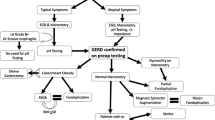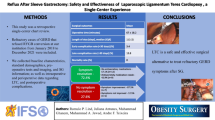Abstract
Background
Transoral intraluminal surgery is less painful. However, endoscopic antireflux procedures have been unsuccessful, endoscopic foregut mucosal excision procedures are often difficult to perform, and endoscopic intra-luminal suturing is both imprecise and too shallow. We have endeavored to correct these deficiencies and report here new devices for GERD, obesity, and Barrett’s mucosal excision.
Method
A retrospective review of ex vivo and in vivo animal experiments using sharp blade mucosal excision for esophageal and gastric mucosa and a suturing device with transverse needles designed to full thickness penetrate the gastric wall were completed. A total of 338 excisions were performed in 134 ex vivo tissue experiments and in 119 in vivo attempts. Suture needle testing was performed in ex vivo human stomachs and porcine stomachs and in in vivo canine and baboon stomachs.
Results
One excision perforation (0.9%) occurred in a live animal. Satisfactory mucosal excision depth for the Barrett’s device was reproducible. Progressive suture actuation reliability improved from 83% during ex vivo testing to 96.7% in in vivo experiments.
Conclusion
The results demonstrate feasibility, reliability, and safety for gastric and esophageal mucosal excision. Suturing reliability improved and further studies will be performed to finalize the instrument designs, the operative techniques, and the other device applications.









Similar content being viewed by others
References
Wolfsen HC, Richards WO. The Stretta procedure for the treatment of GERD: a registry of 558 patients. J Laparoendosc Adv Surg Tech A 2002;12:395–402.
Devière J, Costamagna G, Neuhaus H, et al. Nonresorbable copolymer implantation for gastroesophageal reflux disease: a randomized sham-controlled multicenter trial. Gastroenterology 2005;128:532–540.
Cicala M, Gabbrielli A, Emerenziani S, et al. Effect of endoscopic augmentation of the lower oesophageal sphincter (Gatekeeper reflux repair system) on intraoesophageal dynamic characteristics of acid reflux. Gut 2005;54:183–186.
Schwartz MP, Wellink H, Gooszen HG, et al. Endoscopic gastroplication for the treatment of gastro-oesophageal reflux disease: a randomised, sham-controlled trial. Gut 2007;56:20–28.
Schilling D, Kiesslich R, Galle PR, et al. Endoluminal therapy of GERD with a new endoscopic suturing device. Gastrointest Endosc 2005;62:37–43.
Rothstein R, Filipi C, Caca K, et al. Endoscopic full-thickness plication for the treatment of gastroesophageal reflux disease: A randomized, sham-controlled trial. Gastroenterology 2006;131:704–712.
Cadière GB, Rajan A, Germay O, et al. Endoluminal fundoplication by a transoral device for the treatment of GERD: A feasibility study. Surg Endosc 2008;22:333–342.
Jobe BA, O'Rourke RW, McMahon BP, et al. Transoral endoscopic fundoplication in the treatment of gastroesophageal reflux disease: the anatomic and physiologic basis for reconstruction of the esophagogastric junction using a novel device. Ann Surg 2008;248:69–76.
Rothstein RI. Endoscopic therapy of gastroesophageal reflux disease: outcomes of the randomized-controlled trials done to date. J Clin Gastroenterol 2008;42:594–602.
Moreno C, Closset J, Dugardeyn S, et al. Transoral gastroplasty is safe, feasible, and induces significant weight loss in morbidly obese patients: results of the second human pilot study. Endoscopy 2008;40:406–413.
Devière J, Ojeda Valdes G, Cuevas Herrera L, et al. Safety, feasibility and weight loss after transoral gastroplasty: First human multicenter study. Surg Endosc 2008;22:589–598.
Overholt BF, Panjehpour M, Haydek JM. Photodynamic therapy for Barrett’s esophagus: follow up in 100 patients. Gastrointest Endosc 1999;49:1–7.
Morino M, Rebecchi F, Giaccone C, et al. Endoscopic ablation of Barrett’s esophagus using argon plasma coagulation (APC) following surgical laparoscopic fundoplication. Surg Endosc 2003;17:539–542.
Bowers SP, Mattear SG, Waring PJ, et al. KTP laser ablation of Barrett’s esophagus after anti-reflux surgery results in long-term loss of intestinal metaplasia. Surg Endosc 2003;17:49–54.
Montes CG, Brandalise NA, Deliza R, et al. Antireflux surgery followed by bipolar electrocoagulation in the treatment of Barrett’s esophagus. Gastrointest Endosc 1999;50:173–177.
Ell C, May A, Pech O, et al. Curative endoscopic resection of early esophageal adenocarcinomas (Barrett’s cancer). Gastrointest Endosc 2007;65:3–10.
Maish MS, DeMeester SR. Endoscopic mucosal resection as a staging technique to determine the depth of invasion of esophageal adenocarcinoma. Ann Thorac Surg 2004;78:1777–1782.
Nigro JJ, Hagen JA, DeMeester TR, et al. Occult esophageal adenocarcinoma: extent of disease and implications for effective therapy. Ann Surg 1999;230:433–438.
Pech O, Behrens A, May AD, et al. Long-term results and risk factor analysis for recurrence after curative endoscopic therapy in 349 patients with high-grade intraepithelial neoplasia and mucosal adenocarcinoma in Barrett's oesophagus. Gut 2008;57(9):1200–1206.
Waye JD. Advanced polypectomy. Endosc Clin N Am 2005;15(4):733–756.
Author information
Authors and Affiliations
Corresponding author
Additional information
Financial Support: SafeStitch Medical Inc., 4400 Biscayne Blvd, Suite 670, Miami, FL 33137
Rights and permissions
About this article
Cite this article
Filipi, C.J., Stadlhuber, R.J. Initial Experience with New Intraluminal Devices for GERD Barrett’s Esophagus and Obesity. J Gastrointest Surg 14 (Suppl 1), 121–126 (2010). https://doi.org/10.1007/s11605-009-1027-z
Received:
Accepted:
Published:
Issue Date:
DOI: https://doi.org/10.1007/s11605-009-1027-z




